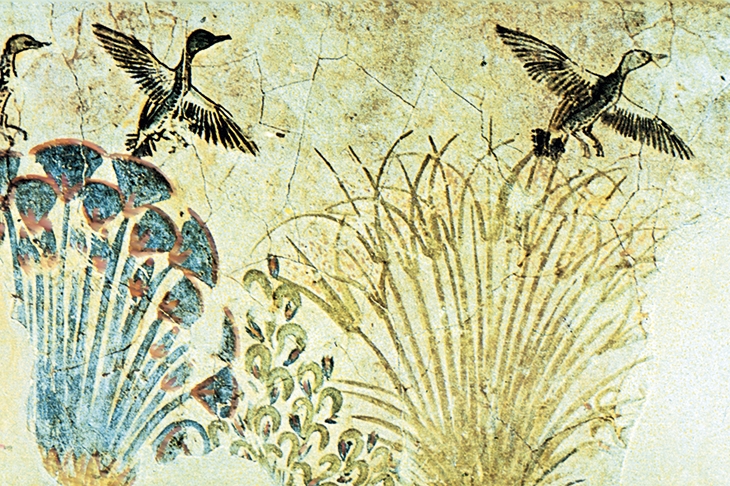In 2016, after some unseemly back-and-forth between the Commons and Lords, it was decided that Acts of Parliament should no longer be printed on calfskin. Instead, new acts are now recorded on paper, though, in a classic parliamentary compromise, they will still be bound between vellum covers. Since the first paper mills appeared in Britain at the end of the 15th century —and paper almost immediately became the dominant medium for print — this means that parliament has managed valiantly to hold back the paper tide for over half a millennium. (To be fair, they only stopped writing acts out by hand in 1849, four centuries
after Gutenberg.)
Meanwhile, over the past 15 years, I have come to conduct most of my daily correspondence by email rather than troubling the postal service. I expect you are the same. But I doubt there are many who will be thrilled if their Valentine’s card turns up as an email attachment, and it’s possible that some of us feel a slight wistfulness that our acts of the land are no longer recorded on the same material as Magna Carta. Sometimes, as Marshall McLuhan put it, the medium is the message.
John Gaudet’s The Pharaoh’s Treasure tells the story of papyrus — the chief writing material of the classical period — from its emergence in Egypt, probably in the fourth millennium BC, to its eclipse, by parchment and paper, in the middle of the first millennium AD. Though other materials were used during this period — clay, wax, parchment — it is papyrus that Pliny has in mind when he writes, of first-century Rome: ‘Our civilisation or at all events our records depend very largely on the employment of paper [chartae]’.
It is Pliny too who gives us the best description of how papyrus was made from the tall wetland sedge that was once abundant in the swampland of the Nile delta. The outer layer of the plant’s stem is stripped away and the pith inside cut into thin slices which are lined up, with another layer placed perpendicularly on top. These are soaked, then squeezed flat and dried out, a process which binds the two layers together, and the resulting sheet is finally polished to give a smooth writing surface. Cheap and light, papyrus was also an excellent vehicle for lengthy texts, since sheets could be joined together and rolled up into one easy-to-store scroll.
Gaudet spends much time on the taste for these scrolls in the modern era and the derring-do of the papyrus-hunters (or looters, if you prefer) of the late 19th century, men such as the British Museum’s Wallis Budge who would use bribery and disguises, secret tunnels and false-bottomed suitcases to evade the authorities in Luxor and Alexandria and swell the collections of museums back home.
At the moment Budge and his rivals, backed by the spending power of their institutions, were chasing down big-ticket scrolls — the Papyrus of Ani and the Book of the Dead were among the most important acquisitions of the day — two archaeologists from Oxford were uncovering another extraordinary papyrus hoard on the site of the ancient town of Oxyrhynchus in Middle Egypt. Here, the town’s rubbish mounds, preserved by the climate, have provided us with what is essentially a vast 2,000-year-old waste-paper basket. Of the Oxyrhynchus papyri, which run to hundreds of thousands of documents, only a tiny fraction are literary; most are full of the ephemera of domestic life. Shopping lists and horoscopes, wills and bills and billets-doux: writing, then as now, was part of the business of everyday life, its moments of long-lasting grandeur only an infinitesimal fraction of the whole.
The geographical particularity of the papyrus sedge gave Egypt an almost total monopoly on papyrus production. Pliny recounts the tale that parchment was invented as a rival product by the people of Pergamon after the pharaoh had capriciously cut off their papyrus supply. It’s a nice story — maybe good things can come out of trade wars — and it acquires a retrospective moral when parchment eventually unseats papyrus as the dominant writing material of the Middle Ages. Sadly, it’s not true. Even in Egypt, writing on leather goes back almost as far as writing on sedge, and the reasons for the decline of papyrus are manifold: the rise of Christianity and its preference for the codex — the folded and stitched book — over the scroll; the fall of Rome; the Islamic conquest of Egypt and the spread of paper; the conversion of swamps to cropland.
In the second half of the first millennium, papyrus had all but disappeared. And yet, until 1022 it was still the material on which all papal bulls were to be issued. The church, like parliament 1,000 years later, has always understood that there is a certain type of authority to be had from being several centuries behind the curve.






Comments